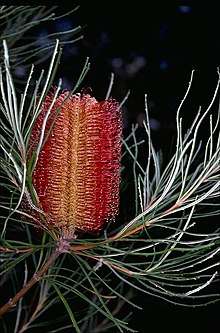Banksia occidentalis
Banksia occidentalis, commonly known as the red swamp banksia,[3] is a species of shrub or small tree that is endemic to the south coast of Western Australia. It has smooth bark, linear, sparsely serrated leaves, golden flowers in a cylindrical spike, and later up to sixty follicles in each spike.
| Red swamp banksia | |
|---|---|
 | |
| Banksia occidentalis in the ANBG | |
| Scientific classification | |
| Kingdom: | Plantae |
| Clade: | Tracheophytes |
| Clade: | Angiosperms |
| Clade: | Eudicots |
| Order: | Proteales |
| Family: | Proteaceae |
| Genus: | Banksia |
| Subgenus: | |
| Species: | B. occidentalis |
| Binomial name | |
| Banksia occidentalis | |
| Synonyms[1] | |
.jpeg)
Description
Banksia occidentalis is a shrub or small tree that typically grows to a height of 1–7 m (3 ft 3 in–23 ft 0 in) and has smooth bark but does not form a lignotuber. The leaves are linear, sparsely serrated, whorled, 40–130 mm (1.6–5.1 in) long, 2–3 mm (0.079–0.118 in) wide on a petiole 1–5 mm (0.039–0.197 in) long. The flowers are arranged in a cylindrical spike 40–140 mm (1.6–5.5 in) long and 65–75 mm (2.6–3.0 in) wide at flowering. The flowers are gold-coloured with red styles, the perianth 17–18 mm (0.67–0.71 in) long and the pistil 29–35 mm (1.1–1.4 in) long and hooked. Flowering occurs from April to May or from August to November or January and the follicles are elliptical, 1–18 mm (0.039–0.709 in) long, 4–7 mm (0.16–0.28 in) high and 3–7 mm (0.12–0.28 in) wide. Up to sixty follicles form in each spike, the old flowers having fallen.[3][4][5][6]
Taxonomy and naming
Banksia occidentalis was first formally described in 1810 by Robert Brown in Transactions of the Linnean Society of London.[7][8] The specific epithet (occidentalis) is a Latin word meaning "western", referring to the distribution of this species relative to the related B. spinulosa.[5][9] George placed this species in section Oncostylis, series Spicigerae.
Distribution and habitat
Red swamp banksia occurs along the south coast of Western Australia between Augusta and Cape Arid National Park where it grows in shrubland or woodland, usually on the edges of swamps but sometimes also on coastal dunes.[3][5][6]
Ecology
A 1980 field study at Cheyne beach showed it to be pollinated by the New Holland honeyeater and white-cheeked honeyeater.[10]
Conservation status
This banksia is listed as "not threatened" by the Western Australian Government Department of Parks and Wildlife.[3]
Use in horticulture
Seeds do not require any treatment, and take 21 to 47 days to germinate.[11] The species was observed to be in cultivation in England in the gardens of Chiswick House in 1834.[12]
References
- "Banksia occientalis". Australian Plant Census. Retrieved 19 May 2020.
- Hooker, William Jackson; Curtis, Samuel (ed.) (1836). "Banksia occidentalis". Curtis's Botanical Magazine. 63: 3535. Retrieved 19 May 2020.CS1 maint: extra text: authors list (link)
- "Banksia occidentalis". FloraBase. Western Australian Government Department of Parks and Wildlife.
- George, Alex S. (1999). Flora of Australia (PDF). 17B. Canberra: Australian Biological Resources Study, Canberra. pp. 234–235. Retrieved 19 May 2020.
- George, Alex S. (1996). The Banksia Book (3rd ed.). Kenthurst, New South Wales: Kangaroo Press. pp. 188–189. ISBN 0-86417-818-2.
- George, Alex S. (1981). "The Genus Banksia L.f. (Proteaceae)". Nuytsia. 3 (3): 404–406. Retrieved 14 May 2020.
- "Banksia occidentalis". APNI. Retrieved 19 May 2020.
- Brown, Robert (1810). "On the Proteaceae of Jussieu". Transactions of the Linnean Society of London. 10 (1): 204. Retrieved 19 May 2020.
- Francis Aubie Sharr (2019). Western Australian Plant Names and their Meanings. Kardinya, Western Australia: Four Gables Press. p. 263. ISBN 9780958034180.
- Hopper, Stephen D. (1980). "Bird and Mammal Pollen Vectors in Banksia Communities at Cheyne Beach, Western Australia". Australian Journal of Botany. 28 (1): 61–75. doi:10.1071/BT9800061.
- Sweedman, Luke; Merritt, David (2006). Australian seeds: a guide to their collection, identification and biology. CSIRO Publishing. p. 203. ISBN 0-643-09298-6.
- J.M. (1835). "Arboretum Britannicum, Nos III. IV. By S.C. Loudon (Review)". The Gentleman's Magazine. Printed by F. Jefferies. 157: 635–637. Retrieved 29 September 2009.
- Taylor, Anne; Hopper, Stephen (1988). The Banksia Atlas (Australian Flora and Fauna Series Number 8). Canberra: Australian Government Publishing Service. ISBN 0-644-07124-9.